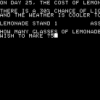Is the idea something like that you get a 360 degree vantage at each overworld node, and then clicking on the things you can see... adds that node to your map? That sounds pretty fun, actually.
I'm glad of it! ^_^
What I have in mind would probably be a little simpler--there would be only a few actual overworld nodes, and while clicking on new locations would likely add them to your map, in many cases going to them would likely result in going to a level rather than a new node, although there would likely be some such.
And for distant things or mysterious places, you get a mixture of truth and rumor, different from each vantage point.
This would actually fit fairly well, I think, since I already have it in mind to have cases in which one has to find clues in order to open up new locations.
In fact, riffing on that, I have the idea of having directions sometimes be given relative to landmarks, which the player can ask after. In the overworld node, the player then has a list of geographical clues, and can attempt to match them to visible locations by dragging and dropping them onto the scene. If correct, that landmark becomes named for the player, and can be used to match further clues for other locations, potentially include some that are out of sight.
If you want to limit your potential workload, you could say that you're looking at the world through a telescopic device, and only some places in the world have them.
Hmm... I like that idea, but I think that I'd prefer to keep it for one or two instances, in which case there might be some adventure-game-style dealings involved in gaining access to the telescopic/scrying crystal/whatever.
Btw, just as random mapspiration, no map gets my imagination going like the Tabula Peutingeriana
Large image warning? :P
More seriously, that's another good idea, although not quite in line with what I have in mind, I think. I do think that it could make for quite an interesting game, however. ^_^






